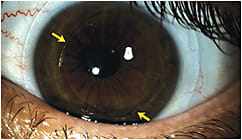For patients that present with spherical or sphero-cylindrical refractive error, it is commonplace for eyecare practitioners to release a final spectacle prescription that allows for best corrected visual acuity. For the subset of these patients who are interested in contact lenses and present with low corneal cylinder (less than 1D), it is almost always an off-the-shelf lens that is first trialed and, subsequently, likely dispensed.
A Unique Opportunity
A series of non-hybrid lens wearers were recruited for an Institutional Review Board approved clinical study. There were 38 subjects enrolled and 32 subjects (64 eyes) completed the study. Investigators followed manufacturer’s recommendations to fit subjects in hybrid contact lenses. Subjects were instructed to wear their lenses on a daily basis for two separate one-week intervals.
Ocular Measurements
Hybrid contact lenses (petrafocon A, hem-larafilcon A) were manufactured for each subject based on keratometric readings, subjective refractive error, and horizontal visible iris diameter. All corneal measurements were acquired using a topographer. Table 1 lists pertinent ocular measurements subject population.
| # OF EYES | Spectacle Cylindrical Power (Mean) | Spectacle Cylindrical Power (St Dev) | Flat Keratometric Reading (Mean) | Flat Keratometric Reading (St Dev) | Steep Keratometric Reading (Mean) | Steep Keratometric Reading (St Dev) | Corneal Cylindrical Power (Mean) | Corneal Cylindrical Power (St Dev) |
| 64 | −0.41D | 0.45D | 43.63D | 1.61D | 44.52D | 1.74D | 0.90D | 0.48D |
Handling, Quality, & Comfort
For the duration of the study, subjects were asked to complete daily Likert scales and end-of-week surveys as measures of patient satisfaction and overall lens performance. While lenses were easy to handle for these novice hybrid lens wearers and visual quality was reportedly excellent throughout the minimum required eight-hours of daily wear, subjects reported initial discomfort with lens wear. This discomfort was noted upon initial application of lens during the study dispense visit and during the first few days of lens application in the morning during the week of wear (Figure 1). As the week progressed, each subject reported improved comfort of lenses both at the beginning and end of the day when first placed on eye and in the evening just before lens removal (Figure 2).


Overall Lens Satisfaction
Subjects were asked to rate their overall satisfaction with lens wear in each eye at the end of each study week. The majority of subjects (85.9%) cited positive satisfaction criteria (very or somewhat satisfied) versus 14.1% of subjects who reported negative satisfaction criteria (very or somewhat unsatisfied).
Clinical Takeaway
While it is unconventional and the above represents a controlled study population, patients who present with low corneal cylindrical power (less than 1D), should not be ruled out as candidates for hybrid lens wear. They can be successfully fit in and wear hybrid contact lenses. CLS




